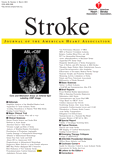导读:研究人员表示,黄酮的摄入量可以降低缺血性中风的发病风险,多吃柑橘类水果或许能减少中风发生几率。

黄酮类化合物(flavonoids)是一类存在于自然界的、具有2-苯基色原酮(flavone)结构的化合物。它们分子中有一个酮式羰基,第一位上的氧原子具碱性,能与强酸成盐,其羟基衍生物多具黄色,故又称黄碱素或黄酮。黄酮类化合物在植物体中通常与糖结合成苷类,小部分以游离态(苷元)的形式存在。绝大多数植物体内都含有黄酮类化合物,它在植物的生长、发育、开花、结果以及抗菌防病等方起着重要的作用。
近日,由英国东英吉利亚大学研究人员开展的这项前瞻性研究共纳入69,622名妇女,通过问卷调查的形式分析参试人员黄酮类物质的摄取量,在14年的随访研究期间,每4年就重复开展一次调查问卷。
结果参试人员中有1,803名女性罹患中风症,工作人员在排除那些潜在影响因素后发现:相比较黄酮摄取量最低组别的女性参试者,那些黄酮摄入量最高组别的女性发生缺血性中风症的相对危险度仅为0.81(95%CI:0.66-0.99,P=0.04)。另外,参试人员摄入的黄酮类物质主要是来源于柑橘类水果或是果汁,数据分析得出柑橘类水果或是果汁有降低罹患缺血性中风的可能性(RR:0.90;95%CI:0.77-1.05),但这一数据并没有统计学上意义。相关研究论文发表在Stroke杂志上。
虽然文章并没有明确证实黄酮类化合物的摄入与中风发病风险呈负相关性(相关数据没有统计意义),但研究人员表示黄酮的摄入量可以降低缺血性中风的发病风险,多吃柑橘类水果或许能减少中风发生几率。要想明确黄酮类化合物与中风之间的相关性还需进一步开展大量前瞻性研究。

Dietary Flavonoids and Risk of Stroke in Women
Aedín Cassidy, PhD; Eric B. Rimm, ScD; éilis J. O'Reilly, ScD; Giancarlo Logroscino, MD, PhD; Colin Kay, PhD; Stephanie E. Chiuve, ScD; Kathryn M. Rexrode, MD, MPH
Background and Purpose: To date, few studies have examined associations between the wide range of flavonoid subclasses and risk of ischemic, hemorrhagic, and total stroke.
Methods: We conducted a prospective study among 69 622 women from the Nurses' Health Study. Total flavonoid and subclass intakes were calculated from semiquantitative food frequency questionnaires collected every 4 years using an updated and extended US Department of Agriculture flavonoid database.
Results: During 14 years of follow-up, 1803 incident strokes were confirmed. After adjusting for potential confounders, women in the highest compared with the lowest quintile of flavanone intake had a relative risk of ischemic stroke of 0.81 (95% CI, 0.66–0.99; P=0.04). Citrus fruits/juices, the main dietary source of flavanones, tended to be associated with a reduced risk for ischemic stroke (relative risk, 0.90; 95% CI, 0.77–1.05) comparing extreme quintiles.
Conclusions: Total flavonoid intake was not inversely associated with risk of stroke; however, increased intake of the flavanone subclass was associated with a reduction in the risk of ischemic stroke. Citrus fruit consumption may be associated with a reduction in stroke risk, and experimental data support these epidemiological associations that the flavanone content of citrus fruits may potentially be cardioprotective. Further prospective studies are needed to confirm these associations.
文献链接:https://stroke.ahajournals.org/content/early/2012/02/23/STROKEAHA.111.637835








